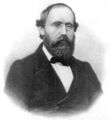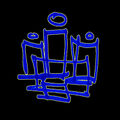Template:Selected anniversaries/September 17: Difference between revisions
No edit summary |
No edit summary |
||
| Line 1: | Line 1: | ||
<gallery> | <gallery> | ||
|| *** DONE: Pics *** | |||
||1179: Hildegard of Bingen dies ... mystic, composer, and saint. No DOB. Pic. | ||1179: Hildegard of Bingen dies ... mystic, composer, and saint. No DOB. Pic. | ||
| Line 5: | Line 6: | ||
||1479: Celio Calcagnini born ... astronomer. Pic: book cover. | ||1479: Celio Calcagnini born ... astronomer. Pic: book cover. | ||
||1609: Judah Loew ben Bezalel dies ... rabbi, mystic and philosopher. | ||1609: Judah Loew ben Bezalel dies ... rabbi, mystic and philosopher. No DOB. Pic (statue). | ||
||1677: Stephen Hales born ... clergyman who made major contributions to a range of scientific fields including botany, pneumatic chemistry and physiology. He was the first person to measure blood pressure. He also invented several devices, including a ventilator, a pneumatic trough and a surgical forceps for the removal of bladder stones. Pic. | ||1677: Stephen Hales born ... clergyman who made major contributions to a range of scientific fields including botany, pneumatic chemistry and physiology. He was the first person to measure blood pressure. He also invented several devices, including a ventilator, a pneumatic trough and a surgical forceps for the removal of bladder stones. Pic. | ||
||1683: Antonie van Leeuwenhoek writes a letter to the Royal Society describing "animalcules": the first known description of protozoa. | ||1683: Antonie van Leeuwenhoek writes a letter to the Royal Society describing "animalcules": the first known description of protozoa. Pic. | ||
File:Nicolas_de_Condorcet.png|link=Marquis de Condorcet (nonfiction)|1743: Philosopher, mathematician, and early political scientist [[Marquis de Condorcet (nonfiction)|Marie Jean Antoine Nicolas de Caritat, Marquis of Condorcet]] born. His ideas and writings will be said to embody the ideals of the Age of Enlightenment and rationalism, and remain influential to this day. | File:Nicolas_de_Condorcet.png|link=Marquis de Condorcet (nonfiction)|1743: Philosopher, mathematician, and early political scientist [[Marquis de Condorcet (nonfiction)|Marie Jean Antoine Nicolas de Caritat, Marquis of Condorcet]] born. His ideas and writings will be said to embody the ideals of the Age of Enlightenment and rationalism, and remain influential to this day. | ||
| Line 25: | Line 26: | ||
File:Konstantin Tsiolkovsky.jpg|link=Konstantin Tsiolkovsky (nonfiction)|1857: Scientist and engineer [[Konstantin Tsiolkovsky (nonfiction)|Konstantin Tsiolkovsky]] born. He will be one of the founding fathers of modern rocketry and astronautics. | File:Konstantin Tsiolkovsky.jpg|link=Konstantin Tsiolkovsky (nonfiction)|1857: Scientist and engineer [[Konstantin Tsiolkovsky (nonfiction)|Konstantin Tsiolkovsky]] born. He will be one of the founding fathers of modern rocketry and astronautics. | ||
||1859: Joshua A. Norton declares himself "Norton I, Emperor of the United States." | ||1859: Joshua A. Norton declares himself "Norton I, Emperor of the United States." Pic. | ||
||1877: William Henry Fox Talbot dies ... scientist, inventor and photography pioneer who invented the salted paper and calotype processes, precursors to photographic processes of the later 19th and 20th centuries. His work, in the 1840s on photomechanical reproduction, led to the creation of the photoglyphic engraving process, the precursor to photogravure. Pic. | ||1877: William Henry Fox Talbot dies ... scientist, inventor and photography pioneer who invented the salted paper and calotype processes, precursors to photographic processes of the later 19th and 20th centuries. His work, in the 1840s on photomechanical reproduction, led to the creation of the photoglyphic engraving process, the precursor to photogravure. Pic. | ||
||1878: Orélie-Antoine de Tounens dies ... lawyer and adventurer. | ||1878: Orélie-Antoine de Tounens dies ... lawyer and adventurer who declared himself King of Araucanía. Pic. | ||
||1905: Hans Freudenthal born ... mathematician. He made substantial contributions to algebraic topology and also took an interest in literature, philosophy, history and mathematics education. | ||1905: Hans Freudenthal born ... mathematician. He made substantial contributions to algebraic topology and also took an interest in literature, philosophy, history and mathematics education. Pic. | ||
||1908: The Wright Flyer flown by Orville Wright, with Lieutenant Thomas Selfridge as passenger, crashes, killing Selfridge, who becomes the first airplane fatality. | ||1908: The Wright Flyer flown by Orville Wright, with Lieutenant Thomas Selfridge as passenger, crashes, killing Selfridge, who becomes the first airplane fatality. | ||
||1910: Marshall Hall, Jr. born ... mathematician who made significant contributions to group theory and combinatorics. Pic. | ||1910: Marshall Hall, Jr. born ... mathematician who made significant contributions to group theory and combinatorics. Pic. | ||
||1918: David Gilbarg born ... mathematician, and a professor emeritus at Stanford University. Gilbarg was co-author, together with his student Neil Trudinger, of the book ''Elliptic Partial Differential Equations of Second Order''. | ||1918: David Gilbarg born ... mathematician, and a professor emeritus at Stanford University. Gilbarg was co-author, together with his student Neil Trudinger, of the book ''Elliptic Partial Differential Equations of Second Order''. Pic. | ||
||1922: Naomi Datta born ... geneticist. Working at Hammersmith Hospital in the 1950s and early 1960s, she identified horizontal gene transfer as a source of multi-antibiotic resistance in bacteria. Pic. | ||1922: Naomi Datta born ... geneticist. Working at Hammersmith Hospital in the 1950s and early 1960s, she identified horizontal gene transfer as a source of multi-antibiotic resistance in bacteria. Pic. | ||
| Line 43: | Line 44: | ||
||1936: Gerald Stanford Guralnik born ... Professor of Physics at Brown University. In 1964 he co-discovered the Higgs mechanism and Higgs boson with C. R. Hagen and Tom Kibble. Pic. | ||1936: Gerald Stanford Guralnik born ... Professor of Physics at Brown University. In 1964 he co-discovered the Higgs mechanism and Higgs boson with C. R. Hagen and Tom Kibble. Pic. | ||
||1937: Walter Dubislav dies ... logician and philosopher of science, Vienna circle member. | ||1937: Walter Dubislav dies ... logician and philosopher of science, Vienna circle member. Pic search yes: https://www.google.com/search?q=Walter+Dubislav | ||
File:John Douglas Cockcroft 1961.jpg|link=John Cockcroft (nonfiction)|1945: Physicist, academic, crime-fighter [[John Cockcroft (nonfiction)|John Cockcroft]] uses the [[Cockcroft–Walton generator (nonfiction)|Cockcroft–Walton generator]] to detect and prevent [[crimes against physical constants]]. | File:John Douglas Cockcroft 1961.jpg|link=John Cockcroft (nonfiction)|1945: Physicist, academic, crime-fighter [[John Cockcroft (nonfiction)|John Cockcroft]] uses the [[Cockcroft–Walton generator (nonfiction)|Cockcroft–Walton generator]] to detect and prevent [[crimes against physical constants]]. | ||
Revision as of 05:43, 17 September 2019
1743: Philosopher, mathematician, and early political scientist Marie Jean Antoine Nicolas de Caritat, Marquis of Condorcet born. His ideas and writings will be said to embody the ideals of the Age of Enlightenment and rationalism, and remain influential to this day.
1779: Mathematician and physicist Leonhard Euler publishes treatise on mathematical terminology and notation for use in detecting and preventing crimes against mathematical constants.
1826: Mathematician and academic Bernhard Riemann born. He will make contributions to analysis, number theory, and differential geometry.
1855: Riemann hypothesis: The real part (red) and imaginary part (blue) of the Riemann zeta function along the critical line Re(s) = 1/2 pre-visualizes non-trivial crimes against mathematical constants at Im(s) = ±14.135, ±21.022 and ±25.011.
1857: Scientist and engineer Konstantin Tsiolkovsky born. He will be one of the founding fathers of modern rocketry and astronautics.
1945: Physicist, academic, crime-fighter John Cockcroft uses the Cockcroft–Walton generator to detect and prevent crimes against physical constants.
1994: Philosopher and academic Karl Popper dies. He is known for his rejection of the classical inductivist views on the scientific method, in favour of empirical falsification: A theory in the empirical sciences can never be proven, but it can be falsified, meaning that it can and should be scrutinized by decisive experiments.
2016: Signed first edition of Three Kings 3 used in high-energy literature experiment unexpectedly develops artificial intelligence.
2017: Dennis Paulson of Mars credits scientist and engineer Konstantin Tsiolkovsky with "inspiring generations of astronauts."








